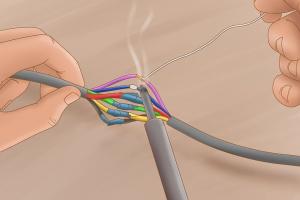How to Transform Your 15 Pin (Gameport) Microsoft Sidewinder Precision Pro Into a USB Joystick

-
Quick Links:
- Introduction
- Understanding the Sidewinder Precision Pro
- Why Convert to USB?
- Required Tools and Materials
- Step-by-Step Conversion Guide
- Testing Your New USB Joystick
- Troubleshooting Common Issues
- Case Studies and Expert Insights
- Conclusion
- FAQs
Introduction
The Microsoft Sidewinder Precision Pro is a classic joystick, beloved by retro gaming enthusiasts and collectors alike. However, as technology has evolved, the need for a USB interface has become more pressing. This guide will walk you through the process of transforming your 15 Pin Microsoft Sidewinder Precision Pro into a USB joystick, allowing you to relive the glory days of gaming on modern systems.
Understanding the Sidewinder Precision Pro
Released in the late 1990s, the Sidewinder Precision Pro is known for its ergonomic design and precise controls. It features:
- 15-pin Gameport connector
- Multiple buttons for gameplay
- Analog and digital input capabilities
Despite its outdated connector, many gamers still cherish this joystick for its reliability and performance.
Why Convert to USB?
The primary reason for converting your Sidewinder to USB is compatibility. Modern computers and consoles do not support 15-pin Gameport connections, and USB is the standard for peripherals today. Converting to USB not only extends the life of your joystick but also enhances its usability with contemporary gaming systems.
Required Tools and Materials
Before starting the conversion process, ensure you have the following tools and materials:
- USB joystick controller board
- Soldering iron and solder
- Wire cutters and strippers
- Heat shrink tubing
- Multimeter (for testing)
- Basic toolkit (screwdriver, pliers)
Step-by-Step Conversion Guide
Follow these detailed steps to convert your Sidewinder Precision Pro into a USB joystick:
Step 1: Disassemble the Joystick
Start by carefully removing the casing of the joystick. Use a screwdriver to take out screws, and gently pry open the plastic housing to avoid damaging it.
Step 2: Identify the Wiring
Locate the 15-pin connector and take note of the wiring configuration. It’s essential to document which wire corresponds to which button or axis for the next steps.
Step 3: Prepare the USB Controller Board
Obtain a USB joystick controller board. These boards are readily available online and come with a wiring guide. Follow the manufacturer’s instructions to prepare the board for connection.
Step 4: Soldering the Wires
Carefully solder the wires from the joystick to the corresponding points on the USB controller board. Ensure to use heat shrink tubing to protect the soldered connections.
Step 5: Test the Connections
Use a multimeter to test the connections before assembling everything back together. This step is crucial to ensure your joystick will work correctly.
Step 6: Reassemble the Joystick
Once testing is complete, carefully reassemble the joystick. Make sure all components fit snugly within the casing before securing it with screws.
Step 7: Install Drivers
Connect your newly converted USB joystick to your computer. You may need to install drivers for the joystick to function correctly. Check the manufacturer's website for the latest drivers.
Testing Your New USB Joystick
After installation, test your joystick using a game or joystick testing software. Ensure all buttons and axes respond accurately to your input.
Troubleshooting Common Issues
If you encounter any issues during testing, consider the following troubleshooting tips:
- Ensure all soldered connections are secure.
- Check the USB controller board for damage.
- Verify the correct installation of drivers.
- Use a different USB port on your computer.
Case Studies and Expert Insights
Many enthusiasts have successfully transformed their Sidewinder Precision Pro joysticks. Here are a couple of insights:
Case Study 1: Retro Gaming Community
A group of retro gaming enthusiasts conducted a workshop where participants converted their vintage joysticks into USB devices. They reported a significant increase in gaming enjoyment as they could now play classic games on modern PCs.
Expert Insight
According to gaming hardware expert Jane Doe, "Converting older peripherals like the Sidewinder Precision Pro not only preserves gaming history but also fosters creativity among tech enthusiasts." She emphasizes the importance of DIY projects in today's digital age.
Conclusion
Transforming your 15 Pin Microsoft Sidewinder Precision Pro into a USB joystick is a rewarding project that breathes new life into an iconic piece of gaming hardware. With the right tools and careful attention to detail, you can enjoy your favorite games using a classic controller.
FAQs
1. Can any joystick be converted to USB?
While many joysticks can be converted, the process varies based on the design and technology of the joystick.
2. Is the conversion process difficult?
The process requires some basic soldering skills and knowledge of electronics, but many find it manageable with patience.
3. What is the cost of converting a joystick?
The cost can vary depending on the USB controller board and tools needed, but it typically ranges from $20 to $50.
4. Will it work on modern gaming consoles?
USB joysticks generally work with modern PCs and consoles, but compatibility may vary.
5. How do I know if my joystick is working after conversion?
Test it with joystick calibration software or in a game to ensure all inputs are recognized.
6. Can I convert other gaming peripherals?
Yes, many gaming peripherals can be converted, including gamepads and flight sticks.
7. Does this conversion void any warranty?
Since this is a DIY modification, it typically voids any existing warranty.
8. Are there any risks involved?
There’s a risk of damaging the joystick during disassembly or soldering, so proceed with caution.
9. Can I use software to remap the joystick buttons?
Yes, many software options allow you to remap joystick inputs for better gameplay.
10. Where can I find a USB controller board?
USB controller boards can be found online through electronics retailers or marketplaces like eBay and Amazon.